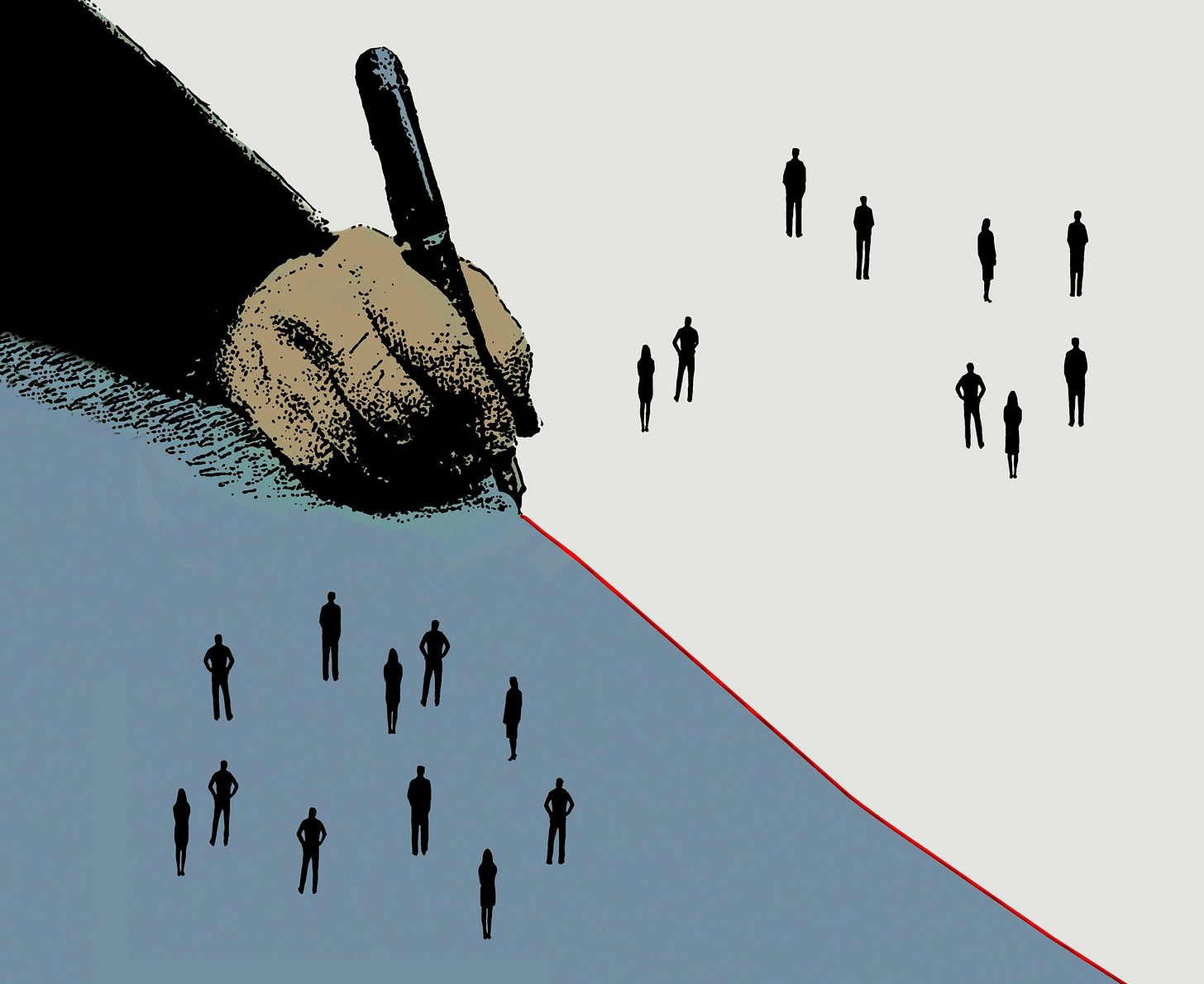CW: characterizations of those who have committed a crime with dehumanizing and degrading language, as well as very brief mentions of rape and other atrocities.
Hidden underneath public and media discourse, a longstanding rhetorical and framing strategy employed by the criminal justice system and its perpetrators has successfully lodged dehumanizing characterizations of “criminals” and “felons” into American mind and matter.
What is that strategy? It consists of othering language that emphasizes the very worst of criminal justice participants, while censoring and smearing away the rest.
To preface: I am not excusing heinous crimes. I am investigating a system that maximizes its agenda for punishment, regardless of your thoughts on crime as either entirely free will or a direct function of environment.
To illustrate, I’ll be breaking this piece into three parts:
A litany of examples of said language
Two case studies: juveniles and undocumented immigrants
The mechanisms and impacts of said strategy (it’s not just semantics)
Our society is so good at comparing criminals to animals that there are entire books published surrounding that topic. Before the Oxford English Dictionary first included the word “criminal” in the late 1600’s, texts used the following terms liberally in early modern times (so like, a REALLY long time ago), up through the 21st century:
caterpillars (prostitutes)
she wolves (female murderers)
beast (rapists)
vagabonds
savage
wilding (search: “Central Park 1989 wilding attack”)
To be clear, I mention early modern times as the starting point only because it falls within the scope of the 354 page book I cite above. England during this time experienced a crime scare, and so the time period was handpicked to explore the relationship between rhetorical choice and fear of crime (hint: it’s pretty significant). Many of these terms, and the analogization of these folks to animals more broadly, very clearly existed before the early modern period as well.
Don’t think this is happening in the 21st century?
“On my first day working arraignments in the Bronx, I’ll never forget hearing court officers calling for “bodies” to be delivered from their “pens” to the courtroom. Accused people, including my clients, were literally being treated like livestock. I quickly realized that so much of the legal lexicon — from “inmate” or “defendant,” to “custody” and “corrections” — serves to sanitize and formalize this dehumanization, while stripping the emotion out of the violence, caging, and deprivation that’s actually taking place.” - Emily Galvin Almanza, co-leader of Partners for Justice
The above describes court proceeding, before anyone has been convicted of a crime.
The criminal justice system has normalized defining its participants by their crimes. We call these participants “criminals” and “felons” and “inmates,” labeling them by one specific dimension (their worst) of the many facets of their identities. These labels have become second nature — I have to actively work to avoid these terms even as I write in opposition to its oppression.
We are most removed from our humanity when we only see the worst in each other.
The construct of a child’s innocence persists through psychology, religion, and culture; it is the dominant frame of childhood.
So what happens when a child commits a serious crime? The criminal justice system stops calling them a juvenile and starts calling them an adult. Our country is the only one where a child can be put into prison for their entire life, without any chance for parole, an extreme sentence even for adults.
The decision to treat a child as an adult is not just a legal distinction; it signals that the criminal justice system is very aware of the dominant social characterization of children and seeks to steer clear of said characterization to save face and credibility.
This is not incidental; it’s intentional.
Shoving children into an adult system of punishment carries very real implications beyond the rhetorical:
“Many youth in the justice system have experienced or witnessed violence and trauma. Youth in the adult criminal justice system face a higher risk of sexual abuse, physical assault, and suicide. Incarcerating children with adults also denies them access to many essential programs and services, including basic and special education, as well as treatment and counseling services, impeding their chances for healthy development. Education is also closely linked to reducing re-offending.”
This is not at all to deny the severity of crime; your opinion about crime as punishment versus rehabilitation regardless, I describe the above to unveil the rhetorical strategies that the criminal justice system utilizes to maximize its agenda.
And if you are against the system, understand it to tear it down.
A hot-button topic in recent elections (in part propagated by Donald Trumps’s 2016 campaign), immigration finds many of its most heinous rhetorical roots in the legal code and the criminal justice system.
Most prominently, the usage of “illegal alien” instead of “undocumented immigrant” for the last few centuries is an open-and-shut example of rhetorical dehumanization (alien literally means non-human). Here are a few instances of its proliferation, from both sides of the aisle:
The Naturalization Act of 1790
Supreme Court Cases (eg. United States v. Martinez-Fuerte, 1976)
State of the Union, 1995 — Bill Clinton
A litany of federal laws
In response, the Carter administration in the 70’s and the current Biden administration have passed orders altering administration terminology from “illegal alien” to “undocumented immigrant.”
Sure, maybe this is a semantic legal technicality, but it’s also not very hard to mask xenophobia with technicalities and crusades against political correctness. People like Trump, who has suggested “that soldiers shoot migrants if they threw rocks,” are, to put it nicely, hard to trust, for this reason.
So how much of this is just a war over political correctness? Do rhetorical frames over the humanity of those entrapped in the criminal justice system actually make that much of a difference?
There’s a reason the criminal justice system is so intentional about its framing. Its primary job is to bring justice through incarceration and punishment, and the frames it has institutionalized do exactly that, in three ways:
First, rhetorical attacks rile up public support, similar to the rally-around-the-flag effect that states use to rile up support for a war. A combination of three survey experiments concluded that efforts to dehumanize the offender “predicted punishment independently of the effects of crime type or crime severity, . . [which] highlight[s] the role of offender dehumanization in punishment decisions.” In other words, when the system calls offenders nasty phrases, regardless of their crime, they are punished more severely.
Second, widespread support for punishment justifies the insane cost for incarceration — it is thus necessary to the survival of the criminal justice system as a “public good” institution to dehumanize its participants. From the Marshall Project:
“The Bureau of Justice Statistics reckons that the United States spends more than $80 billion each year to keep roughly 2.3 million people behind bars. Many experts say that figure is a gross underestimate, though, because it leaves out myriad hidden costs that are often borne by prisoners and their loved ones, with women overwhelmingly shouldering the financial burden.”
Third, dehumanizing those who have committed crimes, which incites public support for dehumanization, allows prisons to cut corners on the basic services that any human is entitled to, which saves money from an otherwise absurdly expensive project. Private prisons are the worst offenders; they regularly cut health care, staff, training, and maintenance. Mental health is an afterthought (or a nonthought), and prisoner suicide is normalized.
All the above depends on the conception of the general public that they are fundamentally “different” from those in the criminal justice system — that they are more human.
This is Bryan Stevenson, founder of the Equal Justice Initiative. Stevenson is responsible for one of the most well-watched videos on TED, and his speech is loaded with rhetorical twists and turns that are powerful precisely because they condemn the false human/subhuman bifurcation.
“Our humanity is everyone’s humanity”
“All of our survival is tied to the survival of everyone”
These lines come at the climax of his talk, and they move mountains not just because of the momentum leading up to their delivery, but because their message carries the inherent implication that our current criminal justice system does not see humanity as all-inclusive and survival as co-dependent.
There is no better example of the outsized influence of framing than in criminal justice. The opinions you hold and the thoughts you have are inextricably interconnected with the words you hear and the way they’re said.
The uneasiness you feel when you see a picture of a mangled prisoner behind bars? Consider that it is that exact uneasiness that is being co-opted against your knowledge and will, to keep that prisoner behind those bars.
Take your mind out of prison.
If you’ve gotten to the end, thank you so much for reading :). Let me know what you think!







